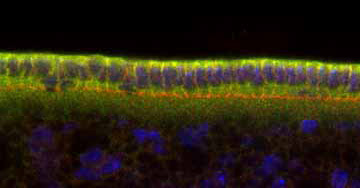Catarina Homem | 2004-2009
 Ph.D. Student, Gulbenkian PhD Programme in Biomedicine (PGDB), PORTUGAL
Ph.D. Student, Gulbenkian PhD Programme in Biomedicine (PGDB), PORTUGAL
Postdoc with Jürgen Knoblich, IMBA, Vienna Austria
Currently: Principal Investigator, CEDOC Chronic Disease Research Center, Lisbon, Portugal
Regulators of cell adhesion and the actin cytoskeleton
Embryonic development requires coordinated tissue movements, cell invagination, and cell shape changes. In order for all these processes to occur normally during the development of an embryo, cells must coordinate adhesion and a highly dynamic cytoskeleton. As it becomes increasingly clear that adhesion, cytoskeletal dynamics and cell contractility are interrelated, it is increasingly relevant to study these processes in whole animals during morphogenesis. It is unclear how changes in the actin cytoskeleton are coordinated with contractility and altered cell adhesion. I am interested in understanding the mechanisms that regulate this coordination during Drosophila morphogenesis.

Rho is a common regulator of both actin and myosin and is also known to be a positive regulator of AJs in both Drosophila and mammalian cells. Rho is an upstream regulator of ROCK through which it regulates myosin, while through Diaphanous (Dia), a formin, Rho regulates the actin cytoskeleton. Recent studies suggest that formins are good candidates to be regulators of actin polymerization at sites of cell-cell adhesion, since they interact with ?-catenin and are important for the stability of cell contacts in mammalian cell culture. Rho regulation of AJs is likely to be mediated by its downstream effectors, including Diaphanous.
We hypothesized that Dia regulates the actomyosin cytoskeleton at adherens junctions during cell shape change, helping coordinate adhesion and contractility of the underlying actomyosin ring. To test this hypothesis we started by characterizing Dia localization during embryogenesis. Diaphanous has a dynamic expression pattern consistent with a role in regulating cell shape change. Diaphanous localizes to the apical domain, overlapping with AJs throughout much of embryonic development. We used loss- and gain-of-function approaches to examine Diaphanous’ role in Drosophila morphogenesis. We used constitutively-active Diaphanous to examine its roles in morphogenesis and its mechanisms of action. This revealed an unexpected role in regulating myosin levels and activity at adherens junctions during cell shape change, suggesting that Diaphanous helps coordinate adhesion and contractility of the underlying actomyosin ring. We tested this hypothesis by reducing Diaphanous function, revealing striking roles in stabilizing adherens junctions and inhibiting cell protrusiveness. These effects also are mediated through coordinated effects on myosin activity and adhesion, suggesting a common mechanism for Diaphanous action during morphogenesis.
Publications
- Homem, C.C.F., and Peifer, M. (2009). Exploring the roles of Diaphanous and Enabled activity in shaping the balance between filopodia and lamellipodia. Molecular Biology of the Cell, in press.
- Gates, J., ,Nowotarski,S.H., Yin, H., Mahaffey, J.P., Bridges, T., Herrera,C., Homem,C.C.F., Janody, F., Montell, D.J.and Peifer,M. (2009) Enabled and Capping protein play important roles in shaping cell behavior during Drosophila oogenesis. Developmental Biology 333, 90-107.
- Homem, C.C.F., and Peifer, M. (2008) Diaphanous regulates myosin and adherens junctions to control
- cell contractility and protrusive behavior during morphogenesis. Development 135, 1005-1018.
- Stevens, T L., Rogers, E M., Koontz, L. M. , Fox, D. T., Homem, C. C.F., Nowotarski, S. H., Artabazon, N. B., and Peifer, M. (2007). Using Bcr-Abl to examine mechanisms by which Abl kinase regulates morphogenesis in Drosophila. Molecular Biology of the Cell 19, 378-393.
- Fox, D.T., Homem, C.C.F., Myster, S.H., Wang, F., Bain, E.E., and Peifer, M. (2005). Rho1 Regulates Drosophila Adherens Junctions Independently of p120ctn. Development 132, 4819-4831.


